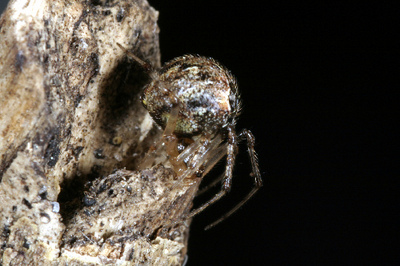Comb-footed Spider
Category: Arachnida Spider

Facts about Comb-footed Spider, "Scientific name for Comb-footed Spider is Chrysso". Spiders are members of the arachnids alongside the mites, ticks, scorpions and harvestmen. The scientists, biologists and zoologists have estimated that there are about 3,000 spider species in the northern parts of America. One of those species is the comb-footed spider, which belongs to the barychelidae family.
Identification of Comb-footed Spider
The Comb-footed Spiders have a small to medium range of size and are fond of climbing the vertical surfaces of objects such as the glasses. The Comb-footed Spider are identifiable by their pairs of stumpy and small spinnerets located under or the end of the body. The head of a comb-footed spider is brown or black and covered with shiny hairs.
Similarly, the body is black or molted brown and covered with hairs. The comb-feet allow the spider to climb objects such as glass in an effortless fashion. Scientists have revealed that its ability to climb objects is a characteristic only shared by the baby tarantula.
Distribution and Diversity of Comb-footed Spiders
Australia, West Pacific and New Caledonia are the diversity spots for the comb-footed trapdoor spiders. They have migrated to the ocean over the ancient years. Whilst many of the comb-footed trapdoor spiders are found in the rainforests, a large number of them are found in the dry places such as the western parts of Australia (Pilbara). Here, the people protect the comb-footed trapdoor spiders for the belief that they only exist in very few areas.
Adaptation
These trapdoors are widely known for burrowing. They do it with one or two doors down or at the entrance of the burrow. Most of them are fond of burrowing in the soils. However, others such as the Sason burrow on the trees. The Brisbane comb-footed trapdoor spiders cryptically burrow a few inches below the top soil. Unlike the other spiders, the Brisbane comb-footed trapdoor spiders like burrowing in the suburbs.
A Comb-footed Spiders stomach can only take liquids, so a spider needs to liquefy their food before they eat. They bite on their prey and empty its stomach liquids into the pray which turns it into a soup for them to drink.
A male Comb-footed Spider has two appendages called "pedipalps" a sensory organ, instead of a penis, which is filled with sperm and insert by the male into the female Comb-footed Spider’s reproductive opening.
Comb-footed Spiders have oversize brains.
In the Comb-footed Spider the oxygen is bound to "hemocyanin" a copper-based protein that turns their blood blue, a molecule that contains copper rather than iron. Iron-based hemoglobin in red blood cells turns the blood red
Comb-footed Spiders have two body parts, the front part of the body is called the Cephalothorax-(the thorax and fused head of spiders). Also on this part of the body is the Comb-footed Spider’s gland that makes the poison and the stomach, fangs, mouth, legs, eyes and brain. Comb-footed Spiders also have these tiny little leg-type things called (pedipalps) that are next to the fangs. They are used to hold food while the spider bites it. The next part of the Comb-footed Spiders body is the abdomen and the abdomens back end is where there is the spinnerets and where the silk producing glands are located.
The muscles in a Comb-footed Spiders legs pull them inward, but the spider can't extend its legs outward. It will pump a watery liquid into its legs that pushes them out. A Comb-footed Spider’s legs and body are covered with lots of hair and these hairs are water-repellent, which trap a thin layer of air around the body so the spiders body doesn't get wet. It allows them to float, this is how some spiders can survive under water for hours. A Comb-footed Spider feels its prey with chemo sensitive hairs on its legs and than feels if the prey is edible. The leg hair picks up smells and vibrations from the air. There are at minimum, two small claws that are at the end of the legs. Each Comb-footed Spiders leg has six joints, giving the spider 48 leg joints. The Comb-footed Spider’s body has oil on it, so the spider doesn't stick to it’s own web.
Comb-footed Spiders do not have a skeletons. They have a hard outer shell called an exoskeleton-(a rigid external covering for the body in some invertebrate animals). The exoskeleton is hard, so it can’t grow with the spider. The young Comb-footed Spiders need to shed their exoskeleton. The spider has to climb out of the old shell through the cephalothorax. Once out, they must spread themselves out before the new exoskeleton will harden. Know they have some room to grow. They stop growing once they fill this shell. Female Comb-footed Spiders are usually bigger than males.
Female Comb-footed Spiders lay eggs on a bed of silk, which she creates right after mating. Once the female Comb-footed Spider lays her eggs, she will than cover them with more silk.
Spiders belong to a group of animals called "arachnids", mites and Scorpions and a tick is also in the arachnid family. An Arachnids is a creature with eight legs, two body parts, no antennae or wings and are not able to chew on food. Spiders are not insects because insects have three main body parts and six legs and most insects have wings.
The Arachnids are even in a larger group of animals called "arthropods" an invertebrate animal of the large phylum Arthropoda, which also include spiders, crustaceans and insects. They are the largest group in the animal world, about 80% of all animals come from this group. There are over a million different species. There are more than 40,000 different types of spiders in the world.

 Back To Category Arachnida Spider
Back To Category Arachnida Spider